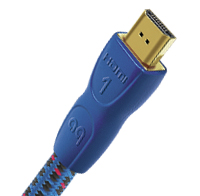What is HDMI?
High-Definition Multimedia Interface, or HDMI, is a digital audio, video and control signal format defined by seven of the largest consumer electronics manufacturers. HDMI specifications and compliance are enforced by an organization called HDMI LLC, which is controlled by representatives from the seven founding companies. Released on 12/9/2002, it is supported by more than 300 companies. HDMI has several advantages over previous connection solutions:
- 1080p and higher resolution capability
- Multichannel high-resolution audio
- One cable for video, audio and control
- Two-way communication for easy system control
- Automatic display and source matching for resolution, format and aspect ratio
- Computer compatibility
- Ethernet/Internet Connectivity
The Evolution of HDMI
 Since HDMIs inception, the capabilities have changed as updates have been made to the specification. Version numbers, such as 1.2, 1.3, and most recently 1.4 and 1.4a, have marked these updates. The majority of the changes involve an increased number of options for manufacturers to choose from. All new versions are compatible with electronics designed to meet previous standards, but will not add features that the existing products in your system do not have. For example, a Blu-ray player with 1080p, built to version 1.3 spec will work with a 1080i television built to version 1.2 spec, but will not give you 1080p.
Since HDMIs inception, the capabilities have changed as updates have been made to the specification. Version numbers, such as 1.2, 1.3, and most recently 1.4 and 1.4a, have marked these updates. The majority of the changes involve an increased number of options for manufacturers to choose from. All new versions are compatible with electronics designed to meet previous standards, but will not add features that the existing products in your system do not have. For example, a Blu-ray player with 1080p, built to version 1.3 spec will work with a 1080i television built to version 1.2 spec, but will not give you 1080p.
The current version of HDMI, version 1.4a, includes many new feature options, including audio return channel, 4k x 2k resolution, support for 3D video and 3D broadcast video formats, as well as support for Ethernet.
Features and Data
Electronics manufacturers must carefully choose from these features. This is because the current HDMI specification limits the amount of data any piece of electronics can send and receive to 10.2 Gbps (Gigabits per second) or less. This limit is not arbitrary, but is based on current technological realities. A good way to think of this is as if HDMI LLC has created a buffet of options and has given you a 10.2 Gbps plate. It is all you can eat, but it must fit on this 10.2 Gbps plate. Some features take up more room on this plate than others, so the electronics manufacturers must determine what features will be most desirable for their customers.
Video Options
- Resolution: Refers to the number of pixels in both the horizontal and vertical direction per frame. Although measured in both dimensions, it is usually referred to by only one of the dimensions.For example, 1080p is 1920

